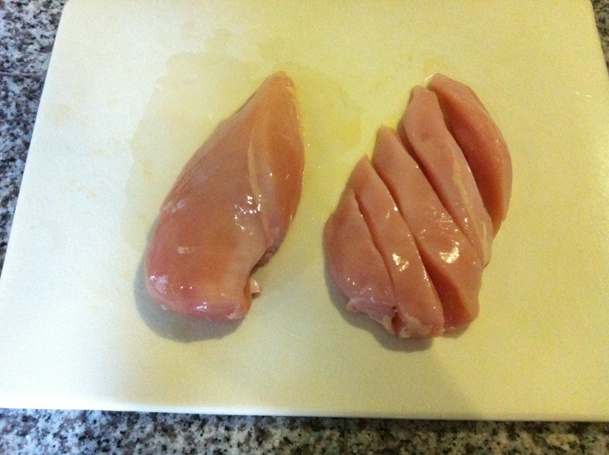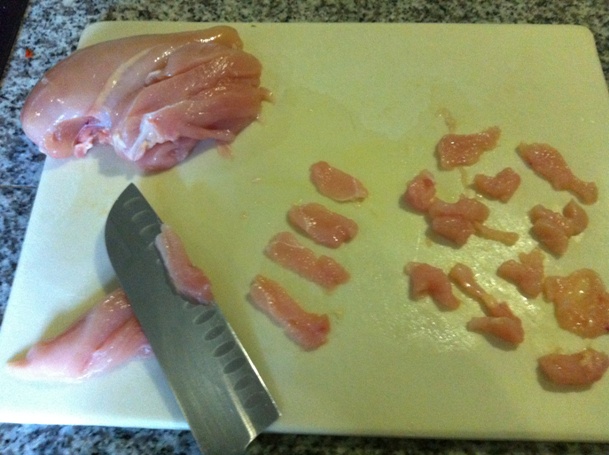This is one of my favorite recipes, and it is a snap to make. Most of the cooking time is unattended, so I can easily browse the internet or do something else while the meal is cooking. It does have a fair bit of prep (chopping), but after that, it pretty much cooks itself with just an occasional stir.
Some Primal or Paleo dieters may not eat sweet potatoes, but I love them. They are nutrition powerhouses, and they lend this dish a subtle (and VERY pleasant) sweetness. However, this recipe is so easily adapted that you could double the amount of cauliflower and leave the sweet potatoes out altogether, or you could substitute an equal amount of many different vegetables, including turnips or butternut squash, or you could even try something like carrots or cabbage if you wanted. You can also make the dish hotter by using hot curry or more curry powder. Once you have the basic technique down, you will see how easy it is to modify this dish. For more notes on possible modifications and suggestions, keep reading after the recipe.
Primal/Paleo Skillet Chicken Curry
2 large chicken breasts (breast halves), sliced into bite-size medallions
2 tablespoons oil (vegetable or coconut), divided
1 large onion, diced
3 or 4 teaspoons Curry Powder (I use ½ hot and ½ sweet curry)
2 teaspoons table salt
8 cloves of garlic, crushed
1 ½ tablespoons fresh ginger, grated or chopped very fine
¾ cup chicken broth (optional—can be replaced by an equal amount of water)
½ head of cauliflower, chopped coarsely into bite-size pieces
3 or 4 medium sweet potatoes, about 1 ½ pounds, cut into bite size pieces
1 cup frozen green peas, thawed
1 small container (8 oz) whole milk yogurt (optional)
½ cup chopped cilantro
To begin, slice your chicken breasts into strips about ¾ inch wide, and then slice each strip into small bite-size medallions. The size and shape are not important, since they will end up tossed into the final dish, so as long as they are small enough to fit onto a fork (and into a mouth!), all will be fine. I would also go ahead and chop the cauliflower into cubes about ¾ inch per side, but again, you are not looking for an exact dice, so a coarse chop is fine. Set the cauliflower aside. If you are fast at grating ginger and chopping garlic, you can wait and do that while the onions are cooking in step two in order to save time, but if you might be a bit slower at this task, go ahead and prepare those two things now and set them aside.
Add 1 tablespoon of the oil to a 12 inch nonstick skillet for which you have a tight fitting lid and put it on the burner over medium-high heat and let it heat up for a few minutes. When it is hot, add the chicken all at once. You will want to stir the chicken every few minutes and continue cooking it until it is done (no pink at all), but we are not looking to brown the chicken here—just cook it through. Meanwhile, while the chicken is cooking, you can quickly chop the onion and measure out the curry and salt (the curry & salt will be added at the same time, so they can be portioned into the same small bowl).
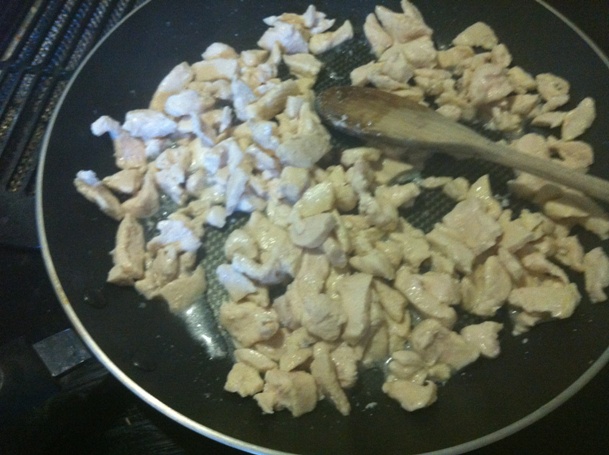
When the chicken is done, dump the contents of the skillet onto a plate and set aside (the chicken will be added back at the end). Add the additional one tablespoon of oil to the skillet and add the onions immediately, since the skillet should still be hot from cooking the chicken. Add the curry powder and salt and stir to combine. The onions should cook for about 5 or 8 minutes over medium-high heat (you can adjust the flame up or down as needed), stirring occasionally. While the onions are cooking, go ahead and grate your ginger and chop the garlic if you haven’t done so already. Also measure out your liquid (chicken broth or water). I recommend that you also peel the sweet potatoes and chop them at the last minute to avoid any discoloration. The onions will be done when they are completely wilted and translucent, and the curry has started to become sticky, so that the onions begin clumping together. Quickly stir in the ginger and garlic and sauté for about 1 minute. Don’t cook too long at this point or the garlic will become bitter.
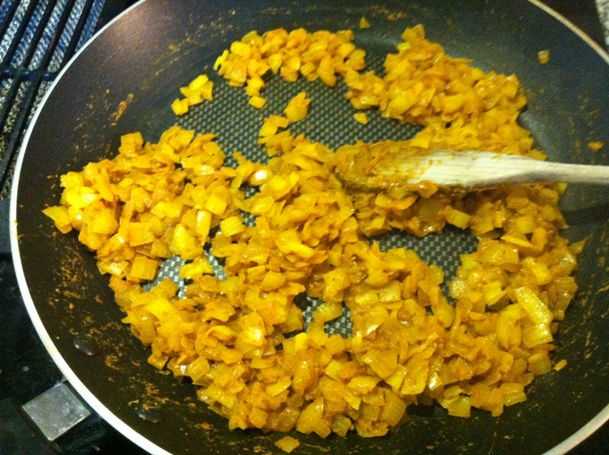
Add the chicken broth (or water—but this is Primal CHICKEN Curry, so go with the broth if you can) and stir to loosen any curry that has become stuck around the edges of the pan. You should have something that looks like a loose onion gravy in the bottom of the pan. Add your cauliflower and sweet potatoes, swirl the pan briefly (no need to stir at this point), and cover the pan tightly. Reduce the heat to medium or medium low. Set a timer for 10 minutes and let the vegetables steam undisturbed for that length of time.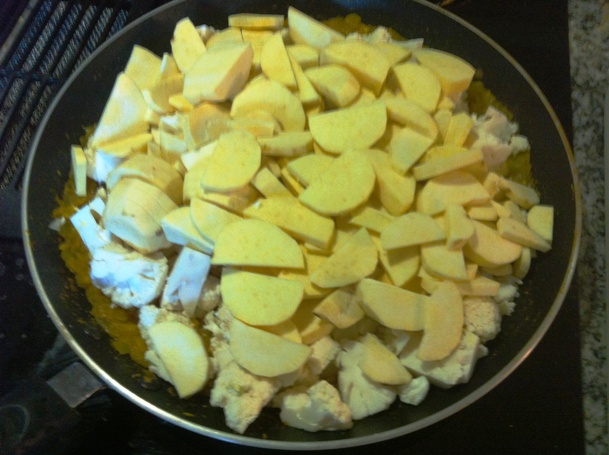
When the timer goes off, remove the lid and stir the vegetables. Since the pan may be full, it might be easiest to lift the vegetables up with a nonstick-safe spatula and turn them over in the pan, rather than trying to stir them in a circular motion. Turn the vegetables until the curry coats everything in the pan (the turmeric in the curry will turn everything yellow, as seen below). Replace the lid and reduce the flame to medium-low or low and let it cook for an additional 10 minutes.
When the timer goes off, stir as before, and if you see any pieces that are looking uncooked, poke them down to the bottom of the pan. Replace the lid and cook an additional 5 or 10 minutes. You can check after 5 minutes, and if the vegetables are done (easily pierced with a fork), continue with the next step. Otherwise, let it cook an additional 5 minutes.
This time, when the timer goes off, it is time to add the cooked chicken and any juices, and the green peas. Stir everything together and let it heat through. If the curry is seeming a little bit watery at this point, you can leave the lid off to let some steam evaporate. Otherwise, replace the lid while the chicken is heating. This step will probably require about 5 minutes.
When the chicken is heated through, remove the pan from the flame. Add the yogurt, if using. I recommend it, since this dish is very low in fat, and the yogurt adds some richness, but it will taste fine without the yogurt. Quickly chop the cilantro, sprinkle over the top of your delicious Paleo Chicken Curry, and stir it in. Dish it up and serve!
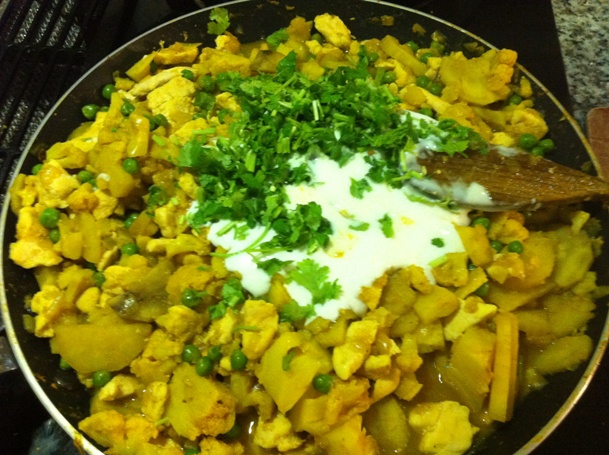
Some notes: The recipe calls for sweet potatoes and cauliflower. If you are omitting the sweet potatoes, you should be aware that cauliflower will absorb much less moisture than the sweet potatoes, so reduce the chicken broth to ½ cup. My favorite sweet potatoes are the white Japanese sweet potatoes, but you can use any kind of sweet potato or yam that you prefer. The Japanese version tends to start discoloring very quickly after being peeled, though, so I usually leave peeling and chopping them until the last minute before I know they are going into the pan (you can see some of the discoloration in my photo above, where the edges of the potato have started to turn dark—and that was only about two minutes after they had been peeled)!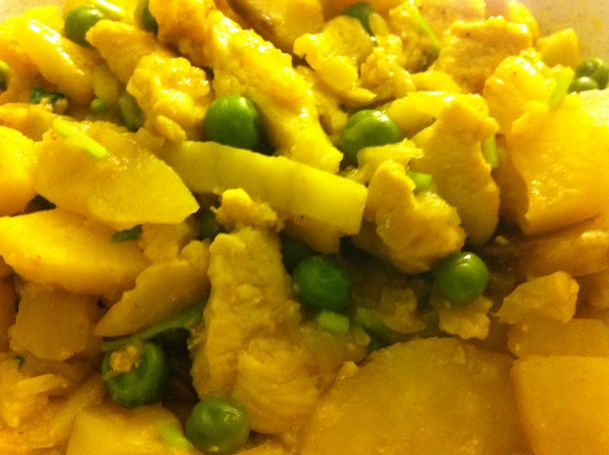
With this basic method and a good 12 inch nonstick skillet, you can improvise many different recipes , including cauliflower rice paella and Jambalaya (I’ll be publishing my recipes for both soon). My absolute favorite is the T-Fal Professional Total Nonstick Saute Pan—by far the best nonstick skillet I’ve ever used—and it’s cheap to boot. The only downside is that it doesn’t come with a lid. Luckily, the lid from my 12 inch All Clad pan (not nonstick) fits it perfectly.
One final note: one of the reasons I love this recipe is because it produces plenty of scraps (potato peel, cauliflower core, cilantro stems) that I can feed to my backyard chickens! Please let me know how you like the recipe!
